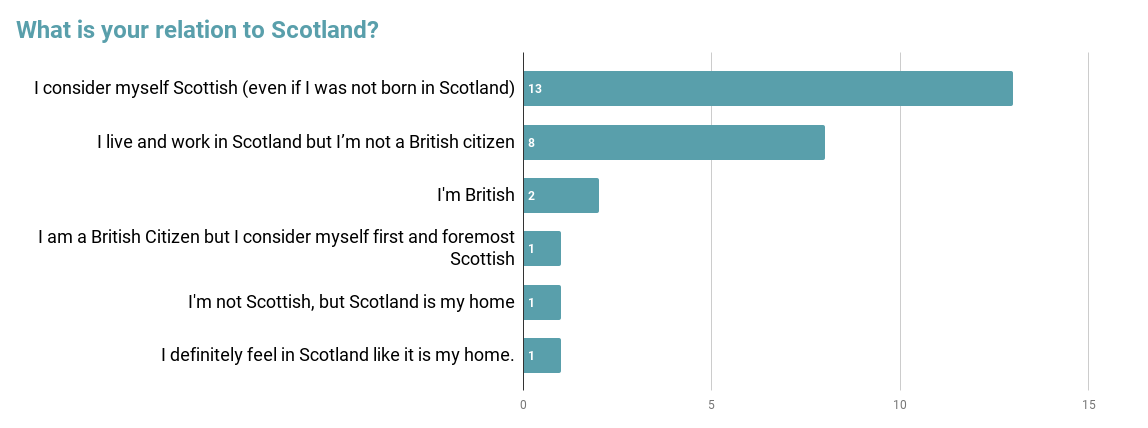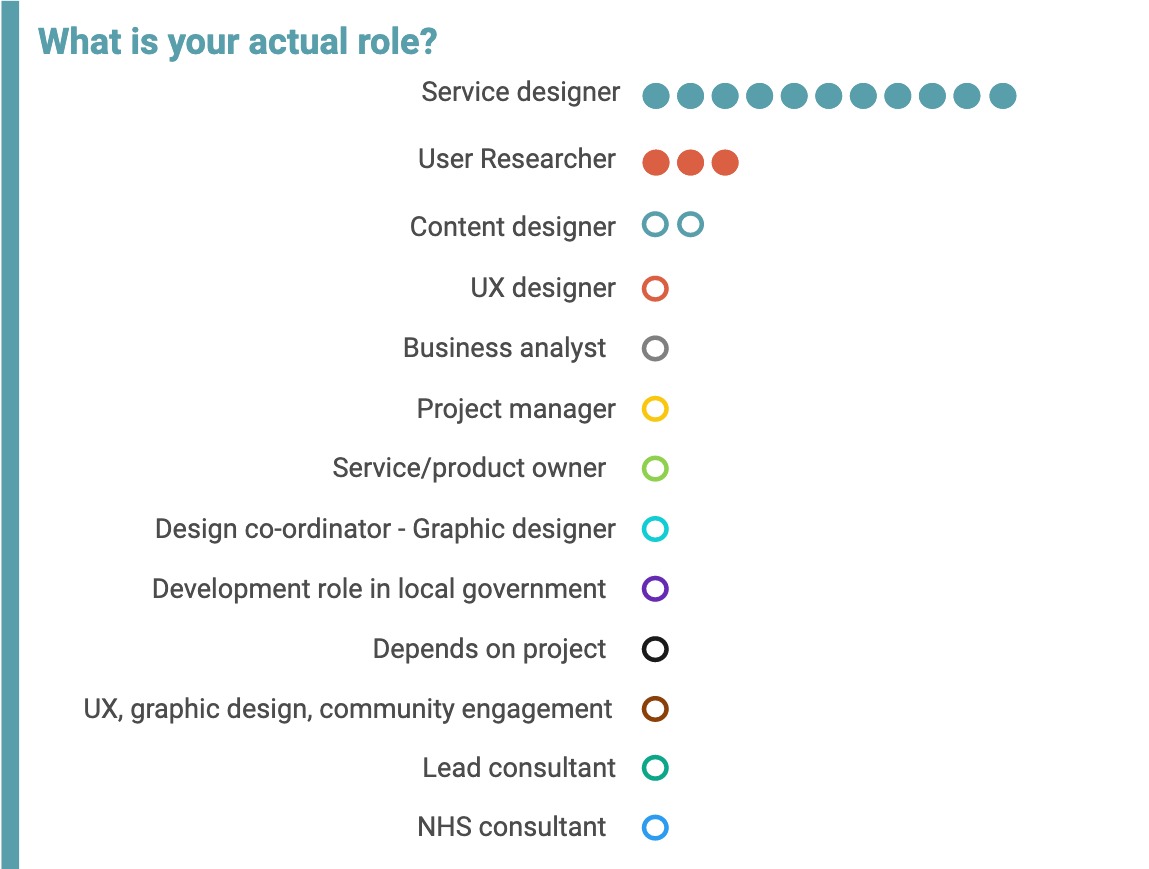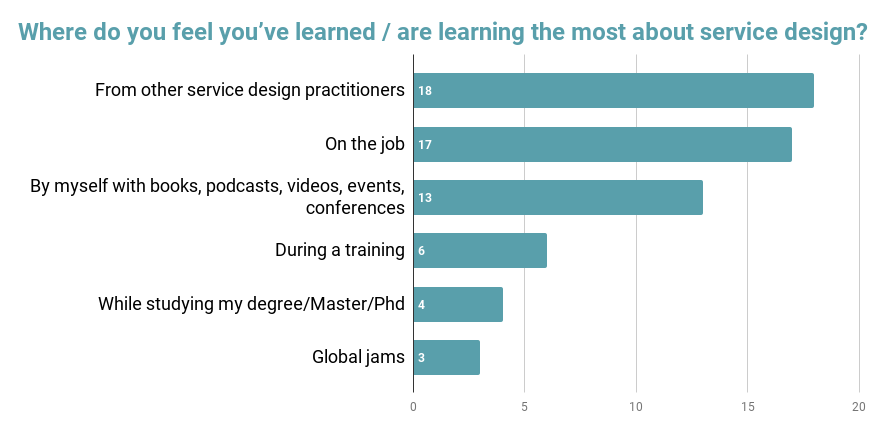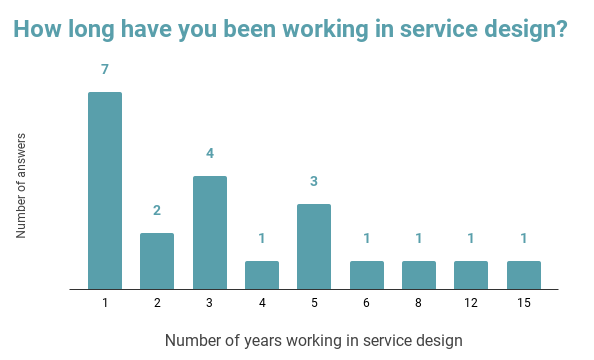
Take the survey
You can still take the survey, it will take about 5 min: Can you tell us about your journey to service design practice?
Quick access to the results so far
Last update: 9 August 2021
- Data
- What people told us
- Why did they choose to work in service design?
- What surprised them when they first started
- Things that have shaped them as a designer
Our research project started with 15 remote interviews of service design practitioners from June to August 2020. We asked them about their journey to service design at the time and wanted to revisit this to get more data, so we created a survey.
We got 31 answers in total, with 24 of them matching our criteria with people:
- using service design approaches
- working in Scotland
- working mostly for the public or third sector
We hoped to get more responses, so we are publishing some interim insights to see if more people would take the survey.

Data
Filtering responses
We started the survey with some questions to ensure that our respondents were practitioners using service design approaches in the public and third sectors in Scotland.
87% considered themselves service design practitioners
The rest didn’t define themselves as such, but later, their answers showed that they did have a service design approach to their work.
The question was: “Are you a service design practitioner? - You don’t need to have service design in your job title. We want to know if you are using service design approaches in your role.” But it seems to have been misleading for some people.
For example: One participant answered ‘No’ to “Are you a service design practitioner?” but when asked: “Why did you choose to work in service design?” they said: “Overall, to improve outcomes for people. Service Design reflects my way of thinking and working.”
Perhaps a clearer question would be: ‘do you use service design approaches in your work?’
People mostly worked in the public sector
Out of the 24 matching our criteria, 16 people work in the public sector and 4 more said they ‘mostly’ work with the public and/or third sector; 2 worked in the third sector.

People were mostly based in Scotland
Out of the 31 answers we had, 26 were based in Scotland, 2 in England, 1 mostly in the UK, 1 in India/Dubai and 1 in Canada.
We only kept the ones who were based in Scotland for our data, but it’s really nice to see that we got interest way beyond Scotland!

Demographics
We made some optional questions to understand basic demographics and contextualise responses - age range, gender, disability, and relationship to Scotland. But we don’t have a large enough sample for these to be representative of the Scottish service design community.
We have now removed these questions from the new version of the survey.
There was a good spread for age

9 between 20 and 29; 10 people were between 30 and 44; 5 between 45 and 59.
Clearly more respondents identified as women
We asked because we noticed that there are a lot of women in the field, but the difference in our responses could also be due to self-recruitment bias - ie. the people that chose to participate in our survey are not necessarily representative of the people working in the field.
One of our interviewees observed that they found more female and international users interested in participating in their user-research groups. We are finding the same. This project was set up by three international women, and so are most of the people who have contacted us to offer help on the project.
A much larger sample would be needed to see if there are indeed more women using service design in the Scottish public and third sectors.
It would be interesting to see a more accurate distribution of the sector and compare seniority and pay by genders, as they did in Mexico in 2018. You can also read the service design salary report 2021 based on data from 1000 service designers across 53 countries.
Service design is a role where you have power (‘power’ defined as the ability to change the life of others / influence decisions) and, as an interviewee noted:
“Ten years ago, the people that were taken seriously by the Government or local Government were old blokes, almost exclusively white.”

18 prefer She/her, 4 He/him, 1 They/them, 1 didn’t answer.
The gender unbalanced was more pronounced in the 7 extra answers which didn’t match our criteria: 6 She/her vs 1 He/him.
Disability
In the UK, about 1 in 5 is disabled. Keeping in mind that this was a very small number of answers, we had a similar proportion in our participants.
Out of 24 people, 4 said they had a disability but didn’t identify as disabled and 1 identified as disabled.

Relation to Scotland
The three of us are EU nationals but working and living in Scotland. We were curious to hear about people’s relation to Scotland. It wasn’t easy to formulate the potential options: How do you define ‘Scottishness’?
Most people considered themselves Scottish. One person even decided to use their own formulation using the “other” option:
“I am a British Citizen but I consider myself first and foremost Scottish”
And two mentioned Scotland as ‘home’
“I definitely feel in Scotland like it is my home.” “I’m not Scottish, but Scotland is my home”


What people told us
Lots of different job titles
Most people are service designers, or user researchers but we had a wide variety of role names.

People mostly learn service design from other practitioners and on the job
We didn’t get a huge number of answers, but there was a clear trend showing that people mostly learn from others and on the job. More than half also mention learning by themselves with books, podcasts, videos, events and conferences.
Training and studying are far behind. Some also mentioned learning by being part of a community. Three mentioned attending a Global service jam which was the start for them.

A lot of people don’t have a diploma related to Service Design
Which probably is one of the reasons for the answers to the previous section. But considering that as many of our participants do have a diploma or are studying toward one, it seems to highlight that learning on the job or from other practitioners feels like a more efficient way to learn.
- 43% have no related diploma or certificate
- 43% have a related PDA (Professional Development Award) or BA, a Master or a PHD - including one studying

Service design is still a pretty new field
Most respondents have been working in service design for less than 5 years
- only 4 participants have been working for more than 5 years in this field
- 30% have only been working in service design for 1 year
- 60% have only been working in service design for 3 years maximum

Practitioners come from very different backgrounds
Other design roles
Content design, UX design, graphic design, research
Tech roles
Software developer, Maths and stats, Performance officer, Engineering, Agile practitioner
…But also:
Politics, international relations, media, journalism, teaching, customer service, fashion, Art, retail, marketing, event organisation, law, NHS consultant, communication, inward investment, corporate.
Most people are planning to keep working in service design
Only 3 said they might not continue.
The potential roles/sectors they might go for next were:
- Industrial design incorporated with User Centred Design/service design
- Design policy
- Design for sustainability
- Design for communities
- Design for environment

Why did they choose to work in service design?
We had similar answers to the one we got during our workshop last year when asked for motivations:
Problem solving, creativity, inspiration
“The work itself is more interesting - a bit of problem solving and logical thinking combined with creative ideas and solutions.”
“Because I could see design thinking to solve public sector problems”
Making the world better
“Work satisfaction for me comes from making someone’s day and helping them to achieve what they need to. Service design is a good fit.”
“Because it allows me to work on a strategic level and make an impact for positive change in the world.”
“I believe that together we can drive social change and contribute to more sustainable futures.”
A lot of people came to it by accident or were in fact doing it without realising it
“Came into it by accident, my Masters’ degree was vaguely about innovation but they taught service design. Then I started working in knowledge exchange, and service design tools and skills became central to my work”
“I just kind of … arrived here.”
“It chose me. I fell in love with the process and the practice through Jamming.”
“When I realised I’d been doing bits of it all along, without knowing that’s what it was, and realised it could be a job in itself, how could I NOT choose to?!”
“I got an internship with a Service Design company which completely immersed me in everything design. I loved it from Day 1”
“The methodology articulated what I saw as ‘common sense’ in an approach/ way of thinking.”
But also frustration
“Frustrated by the madness of Local Government but was unable to do anything, so looked for a role that would let me influence and improve things”
“Lack of industrial design jobs in Scotland”

What surprised them when they first started
Service Design in Scotland is very small world
“How it seems like everyone in Scotland knows each other in the service design world”
Manager and colleagues don’t always get it
“I found it surprising that it took us so long to discover Service Design and to start working this way. On the other hand some colleagues > are still struggling to embrace it.”
“Clients’ lack of knowledge of their users”
“Managers in high up positions don’t have it all figured out and struggle with basic things that we as practitioners take for granted”
“How difficult it is to get people to base decisions on evidence rather than intuition”
“How hard it is to convince big orgs of the importance and possibilities of user centred design”
Some practitioners are also still figuring out
“Others who were super experienced compared to me were in fact not that much further ahead of me. We are all still making it up as we go along”
“After many years on the periphery of service design, I don’t know what it is. Or I feel I know really well how to be a participant in it but not how to be a practitioner.”
“Honestly, that ‘service design’ itself is a role. I’d never heard of it, and had previously only worked with UX designers and strategists.”
Some practitioners don’t share or help others to engage
“Service designers don’t share their practice / don’t collaborate in a way that allows people who don’t come from their training engage. They assume knowledge, they exclude. I’d hoped to get more involved in SD through my UR role but it’s not been possible. Also that practitioners seem precious about sharing their thinking and ways of working.”
The need for abstraction and creative thinking
“The level of creative thinking needed”
“How abstract it can be.”
“Realising that it is about how things work, it’s about people, rather than how things look (although that obviously plays a part too, especially in how the visual enables all the other aspects) was life changing”
The fact that it works and to be taken seriously
“How much things improve by doing user research”
“I am a relatively young practitioner, I was surprised to be taken seriously.”
Hard to embed and ineffective when divorced from delivery
(These quotes come from the data we didn’t keep but are still interesting)
“How ineffective service design is if it’s divorced from delivery channels”
“How broad the field is”

Things that have shaped them as a designer
People!
The people I work with, colleagues, Design lecturers, family members
Being part of a community
SDN, Slack, SDSGather, Twitter, the Service Education Network
Doing user research
Attending a course
GSA, Service Design Academy and more were mentioned but also mentoring
Conferences and events
SDinGOV, UCD Gathering, UX in Scotland, EduJam
Books
- Good Services by Lou Downe
- Design for the Real World By Victor Papanek
- Andrea Branzi (4th metropoli book)
- The Italian radical thinkers of Archizoom
- The book Women’s Ways of Knowing
- Sense & respond by Jeff Gothelf
- Radical help by Hilary Cottam
Articles and insights from the service design/UX world
Gov service, Co-op, Deliveroo, Uber, Content Design London
Major events: like the Scottish Independence Referendum, Rosa Parks and Climate Change
“I realised that we needed to design better ways for communities to know each other and for people to see political engagement as relevant to them rather than something far removed from their lives. This changed the course of what and how I designed.”
“Rosa Parks bus boycott”
“Climate change has been a huge problem and we need collaborators and designers to transform present linear models to circular models. The case studies around these, transformation design has been a great inspiration for me.”
“Losing a friend - searching for meaning and a more practical way to use my design skills to help people. The pandemic - wanting to use my skills to have positive impact on people’s lives, however small.”
Who they are and their lived experience
“I am a Queer person in the service design space […] My life experiences as part of the LGBTQ+ community influences my everyday decisions, input and unconscious bias so I think this is important to add.”
“Growing up with Adverse Childhood Experiences - poverty, addiction, domestic abuse, care, death - and being failed by a system that was supposed to help my family”
Funding
“Funded Education - Fully SASS funded and then Scholarship to do a masters. It allowed me the opportunity and support to explore what craft, design and art can do in the world. I could never have done it without it”
Previous bad work experience
“Previous work environments (mostly knowing how I DON’T want to work and approach projects)”
